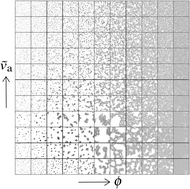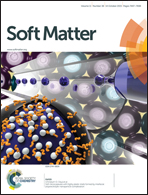Clustering and phase behaviour of attractive active particles with hydrodynamics†
Abstract
We simulate clustering, phase separation and hexatic ordering in a monolayered suspension of active squirming disks subject to an attractive Lennard-Jones-like pairwise interaction potential, taking hydrodynamic interactions between the particles fully into account. By comparing the hydrodynamic case with counterpart simulations for passive and active Brownian particles, we elucidate the relative roles of self-propulsion, interparticle attraction, and hydrodynamic interactions in determining clustering and phase behaviour. Even in the presence of an attractive potential, we find that hydrodynamic interactions strongly suppress the motility induced phase separation that might a priori have been expected in a highly active suspension. Instead, we find only a weak tendency for the particles to form stringlike clusters in this regime. At lower activities we demonstrate phase behaviour that is broadly equivalent to that of the counterpart passive system at low temperatures, characterized by regimes of gas–liquid, gas–solid and liquid–solid phase coexistence. In this way, we suggest that a dimensionless quantity representing the level of activity relative to the strength of attraction plays the role of something like an effective non-equilibrium temperature, counterpart to the (dimensionless) true thermodynamic temperature in the passive system. However there are also some important differences from the equilibrium case, most notably with regards the degree of hexatic ordering, which we discuss carefully.


 Please wait while we load your content...
Please wait while we load your content...